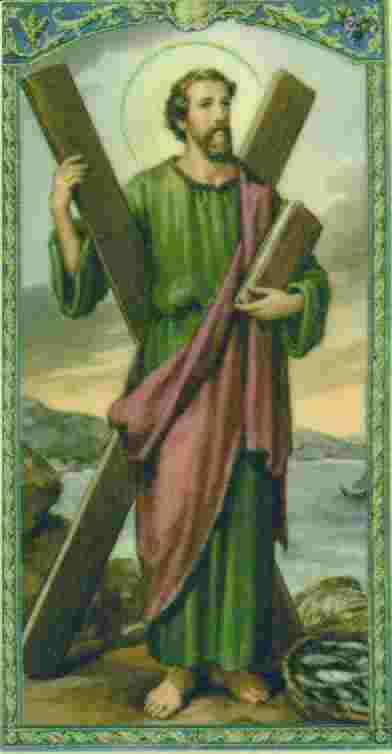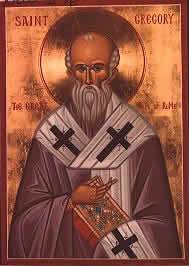
Saint Aidan
Memorial: 31st August
Died: 31 August 651AD, Northumberland, England
Born in Ireland, St Aidan became a monk whose tutor was Saint Senan. He subsequently held the post of Bishop of Northumbria. When pagans attacked King Oswald's forces at Bambrugh, they piled wood around the city wall to burn it. Saint Aidan prayed for help and a change of wind blew the smoke and flames over the pagan army. Saint Aidan also founded the Lindisfarne monastery that became a great storehouse of European literature and learning during the dark ages. He died of natural causes on 31st August 651 at Bambrugh. The young Saint Cuthbert, a shepherd in the fields at the time, saw Aidan's soul rise to heaven as a shaft of light. Saint Aidan is buried at Lindisfarne.
 Saint Andrew the Apostle
Saint Andrew the Apostle
Memorial: 30th November
Died: c.69AD, Achaia, Israel
St Andrew was born at Bethsaida, Northern Israel. A fisherman by trade, he was a follower of John the Baptist and the first apostle of Jesus Christ. His life was centred on leading people to Jesus before and after the Crucifixion.
His mission led him to Asia Minor, Greece and possibly areas in modern Russia and Poland. He is said to have preached for two days whilst being martyred on a saltire (x-shaped) cross. There are a number of explanations why
Andrew became the patron of Scotland including:
(1) In 345, Emperor Constantine the Great decided to move Andrew's bones from Patras to Constantinople. Saint Regulus was instructed by an angel to take many of these relics to
the far northwest. He was eventually told to stop on the Fife coast of Scotland, where he founded the settlement of Saint Andrew.
(2) When the Pictish King Angus faced a large invading army, he prayed for guidance. A white cloud in the form of a saltire cross floated across the blue sky above him. Angus won a decisive victory, and decreed that Andrew
would be the patron saint of his country.
The Declaration of Arbroath officially named Saint Andrew the patron saint of Scotland following Robert Bruce's victory at the Battle of Bannockburn in 1314. The Saltire became the
symbol on the national flag of Scotland in 1385.
 Saint Gregory the Great
Saint Gregory the Great
Memorial: 3rd September
Died: 12 March 604AD Rome, Italy
St Gregory was the son of a wealthy Roman senator and Saint Silvia. He was trained by the finest teachers in Rome. Prefect of Rome for only one year, he sold his possessions and turned his home into a Benedictine Monastery. He used
his money to build six monasteries in Sicily and one in Rome. He gave up his role as a Benedictine Monk after seeing English children being sold in the Roman Forum. He became a missionary to England and was elected Pope by unanimous
acclamation on 3 September 590. He sent Saint Augustine of Canterbury and a company of monks to evangelise England. Other missionaries were sent to France, Spain and Africa.
Saint Gregory collected the melodies and plain chant
now known as Gregorian Chants. He was one of the four great Doctors of the Latin Church, writing seminal works on the Mass and Office.
 Saint Oswald
Saint Oswald
Memorial: 28th February
Died: 29th February 992, Worcester, England
St Oswald's parents came from Denmark to England before his birth. He was educated by his uncle, Saint Odo of Canterbury.
St Oswald's roles included: Priest in the Diocese of Winchester England, Benedictine monk at Fleury-sur-Loire, France, Bishop of Worcester, England (962) and Archbishop of York (972).
He founded the monasteries at Ramsey,
Westbury, Worcester and Winchester. Working with Saint Dunstan and Saint Ethelwold (from 961), he revived monastic and ecclesiastical discipline in England. Although he was promoted Archbishop of York in 972, he retained the government
of the see of Worcester, for which he had a special affection.
He wrote theological treaties and worked for the improved theological training of his clergy.
St Oswald died in the act of washing the feet of the poor, as
was his daily custom during Lent. He was buried in the Church of St Mary at Worcester.